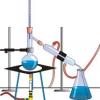Hi all
This feels like a simple enough question but its got me stumped.
I have a pipe carrying a mixture of natural gas and liquids (say C1 - C6+ including H2Sand CO2). Suddenly the pipe has a rupture (1 cm diameter leak).
(i) How would you calculate the rate of release of liquid/gas? I've seen the formulae in the link below which include coefficeint of discharge from bernoulli's equation, but I cant find any sources for it in any of my usual texts? Does anyone have any references or better formulae to use?
http://www.engineeri...turi-d_590.html
(ii) I'm assuming that the composition of my released product will change over time. How can I assess this? How does my composition change over time?
Thanks a million!
Ogeds
|
|

Leaking Pressurised Pipe Containing Hydrocarbon Gas/liquid Mixture
Started by Olaniyi, Sep 18 2012 10:44 AM
3 replies to this topic
Share this topic:
#1

Posted 18 September 2012 - 10:44 AM
#2

Posted 24 September 2012 - 02:03 PM
Ogeds,
This problem amounts to two-phase flow through an orifice. If the pressure in the pipeline is more than about 2 bara, it will be critical flow.
For this flow problem I recommend that you use the Homogeneous Equilibrium Method (HEM). This method was developed at Imperial College, UK, by Hewitt, Richardson and Saville, in 1999 - 2000 and has been experimentally validated by them. It now forms the basis for sizing two-phase relief valves in most oil company standards. It is simple and thermodynamically rigorous.Your leakage orifice is essentially the same physical situation except the upstream pressure will decrease with time.
I suggest you read up about this calculation method via Google. Forget the venturi method, that is not relevant.
I don't think you need to worry about composition changing with time. Maybe the gas and liquid would not be uniformly mixed over the entire leakage duration, but so what?
Paul
This problem amounts to two-phase flow through an orifice. If the pressure in the pipeline is more than about 2 bara, it will be critical flow.
For this flow problem I recommend that you use the Homogeneous Equilibrium Method (HEM). This method was developed at Imperial College, UK, by Hewitt, Richardson and Saville, in 1999 - 2000 and has been experimentally validated by them. It now forms the basis for sizing two-phase relief valves in most oil company standards. It is simple and thermodynamically rigorous.Your leakage orifice is essentially the same physical situation except the upstream pressure will decrease with time.
I suggest you read up about this calculation method via Google. Forget the venturi method, that is not relevant.
I don't think you need to worry about composition changing with time. Maybe the gas and liquid would not be uniformly mixed over the entire leakage duration, but so what?
Paul
#3

Posted 24 September 2012 - 11:12 PM
Hi ,
Let you consider this resource , may not suitable for your case .
http://www.air-dispe...om/usource.html
Breizh
Let you consider this resource , may not suitable for your case .
http://www.air-dispe...om/usource.html
Breizh
#4

Posted 28 September 2012 - 01:57 AM
Thanks!
Similar Topics
Liquid Liquid Separator SizingStarted by Guest_Kentucky08_* , 03 Apr 2025 |
|

|
||
Steam Carrying Liquid From The Sour Water Stripping TowerStarted by Guest_kaidlut_* , 12 Sep 2024 |
|

|
||
Modeling Liquid Metals In Aspen PlusStarted by Guest_AnthonyB_* , 03 Apr 2025 |
|

|
||
Pressurizing LiquidStarted by Guest_Ahmadhamzahperta_* , 02 Apr 2025 |
|

|
||
Modeling Liquid-Liquid Membranes In Aspen PlusStarted by Guest_bodinjas_* , 18 Mar 2025 |
|

|

 FB
FB







